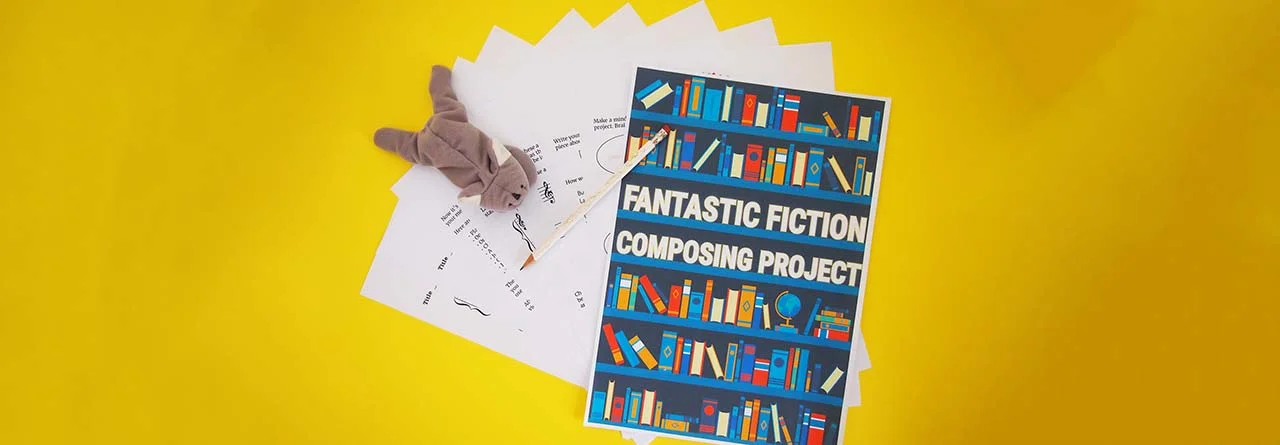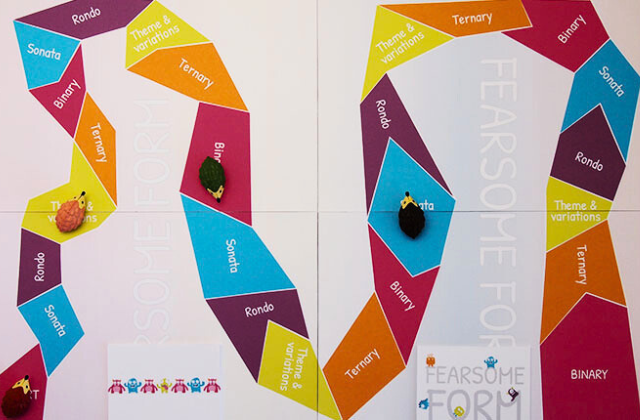
This blog post about how to teach music form effectively and efficiently was written by Carmen Carpenter. Carmen has taught music in a school setting as well as in her home studio for over 30 years. Teaching combines two of her favourite things: music and kids! Besides teaching music, Carmen loves spending time with family playing games, working puzzles and watching movies. She is also an avid reader and loves taking long walks on her local, woodsy trails.
For most of us, it’s quick and easy to simply point out the form of a student’s piece and assume they understand the information we’re sharing. We hope that, eventually, they’ll just automatically be able to spot the structure in their music.
But does that really work? Do they actually start to recognise form on their own, through osmosis?

Frankly, that has not been my experience.
When I use dry explanations to teach form to music students, it usually just goes in one ear and out the other.
Getting students fully engaged with their music, however, helps them see the puzzle pieces in a whole new way.
Instead of relying on the old “sit and get” method for our students, let’s facilitate learning the anatomy of music through movement, discovery, creativity, colour and games.
Approach 1: Movement
While piano and instrument learning is a kinesthetic experience, it’s also fairly cerebral and tends to focus on aural and/or visual learners.
Form lends itself to active learning. With movement activities, we can occupy our ants-in-the-pants students while also engaging our calmer ones.
Adding movement to a piece can be as simple as clapping the beat during the A section and patsching (tapping your lap) during the B section. Or it can be more elaborate by adding complex choreography or even props.
Parachute
When I taught elementary (primary) school music, one of my favourite ways to teach form was with a parachute.
Now, of course using a parachute in a 1-on-1 lesson, or even a buddy lesson, would be a challenge. But you could certainly use one in a group lesson setting.
Even better, teach a group lesson or piano party about music form and use a parachute then.
Use the parachute to emphasise the various sections of a piece by doing simple actions. For example, have students make side-to-side, swishy motions for the A part and slow, up-down movements for B. If there’s a C section, students could hold the parachute in one hand and walk in a circle. You could even get really fancy and switch directions halfway through the section.
If you do a parachute activity, you’ll definitely make a memory that you can point to later when discussing form in your regular lessons.
Scarves
Scarves are another great prop to have on hand when teaching form. For example, have your student wave high when they hear the A section and wave down low when they hear the B section.

Better still, let your student create their own movements for the different sections. (You can just watch them go with it, if you want to, but I’m the kind who likes to join the fun. 🥳)
Approach 2: Discovery
When students are allowed to uncover information for themselves, their learning sticks so much better. Try some of these ideas to give your students that “aha” feeling about learning form.
Movement Discussion
Movement was mentioned above as a way to delineate the structure of a piece, but please don’t ruin the possibility of discovery for your students by announcing “These are the actions for the A section. These are the actions for the B section….” before you start.
Listen to the music and simply change your movements when the section changes, as though the actions have no meaning other than something fun to do. Have your students mimic whatever you’re doing. Then ask:
- Why do you think we changed our movements at the places we did?
- How could we name each of the different actions to help us roadmap the piece?
- How are the actions we did helpful in understanding the structure of this piece?
Guided Listening
Have your student listen to a piece and raise their hand when the music seems to change. Ask them what made them raise their hand – in what specific ways did the music change?
Once you and your student have described the different sections, then you can help them to denote the different sections with letters, shapes or colours.
For more tips, tricks and resources about teaching music theory concepts, check out the Colourful Keys hub page entirely devoted to Teaching Music Theory.
Approach 3: Creativity
Getting creative is another great strategy to teach and reinforce form with your music students.
Composing
Try starting a composition by keeping the primary focus on form rather than melody, rhythm, mood, etc.
The Vibrant Music Teaching (VMT) Library has loads of possibilities to help you get students composing with form in mind. One of my favourites is the ’Fantastic Fiction Composing Project’. My students have had a blast with this project!
In this approach, part of the composing process is developing the structure of the piece. When students are designing the form themselves through composition, the learning is much deeper and stickier.
To get your free copy of the ’Fantastic Fiction Composing Project’, simply enter your info below.

Subscribe to the newsletter and get the Fantastic Fiction Composing Project
Enter your details to subscribe to the newsletter for piano teachers with information, tips and offers.
I hate spam as much as you do! I will only send you emails related directly to piano teaching and you can unsubscribe at any time.
Members of VMT can download that and other composing projects from the VMT Library. Not a member? Learn about the library and more at vibrantmusicteaching.com.
Not only did my students get to dream up ways to musically express their best-loved characters or scenes from books or movies, they also got a much deeper understanding of form.
Improvising
You can also deepen understanding of form in your student’s music by having them work out the harmonic structure of one section in their piece. They can then use that same structure to improvise the section, replacing the melodic line with their own.
Improvising different sections independently of each other gives each section a more distinct “identity”, making it easier for students to understand and recognise the form.
Approach 4: Colour
Kids love to use highlighters to recognise and delineate the layout of their pieces! I recently discovered gel highlighters and they are a huge hit. Eraseable highlighters are great, as well, especially if your student has borrowed their music from your studio’s lending library.
I like to have my students make a box around same sections using the same colour. (For example, draw a purple box around all the A sections.) I feel that colouring the entire grand staff is a bit too much, but you do you.
A teacher friend of mine likes to use removable highlighter tape and narrow washi tape to designate the different sections of a piece.
If you believe that a lot of colour is too distracting, you could use small, colourful stickers to mark the first bar of each section. Or use a coloured pencil to draw shapes at the beginning of each section of a piece.
Approach 5: Games
After all, this is Colourful Keys – how could we write a post about fun ways to teach music form and not include games? 😆
Grab some dice or a deck of cards and create your own music theory game to help you teach form.
If you’re a member of Vibrant Music Teaching, you don’t need to make up your own. Check out ‘Fearsome Form’ in the Printable Library – it’s the perfect way to help intermediate/grade 3 – 4 students get to grips with common musical structures while having fun figuring out the monster characters.
What are some fun ways you like to use to teach music form?
We’d love to hear your ideas; just pop them in the comments below. 😀

